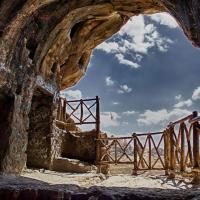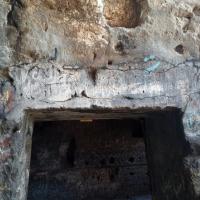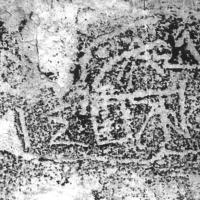Greek apotropaic inscription
Inscription
Ἡρακλῆς ἐ̣ν̣[θ]άδε κατοικεῖ·
μηθὲν εἰσέλθοι κακόν.
Heracles resides here.
May nothing evil enter.
Inscription Credits
Ancient text after Rougemont, G. 2012. Inscriptions grecques d'Iran et d'Asie centrale, avec des contributions de Paul Bernard. Corpus Inscriptionum Iranicarum, part II, vol. I.1. London: no. 75. Reproduced by permission of Georges Rougemont and the Corpus Inscriptionum Iranicarum.
Comment
The text, recorded in 1819 by Robert Ker Porter (1822: 540-542; see now Rougemont 2012: no. 75, with earlier bibliography), is carved over one of the main entrances of the extended, partly manmade cave complex at Karaftō cliffs, some 150 km to the southeast of Lake Urmia. It is ascribed on paleographic grounds to the early Hellenistic period and is one of the few known Greek inscriptions preserved in situ in Iran.
Following a suggestion by William W. Tarn (1929), Aurel Stein (1938: 336-337; idem 1940: 339, 342-343. Cf., e.g., von Gall 1978: 99-112; idem 2010) identified the Karaftō cliffs with Mt. Sanbulos at the frontier of Media Atropatene, where, according to Tacitus (Ann. 12.13), the Parthian king Gōdarz II (first century AD) offered 'vows to local deities, the chief cult' ―apparently of an oracular character― 'being that of Heracles'. Stein thus interpreted the cave complex as an oracular sanctuary of a native divinity, possibly the Iranian Vərəθraγna (for Heracles/Vərəθraγna, see conveniently de Jong 2003), who would have been known presumably as Heracles to the Greek carver of the inscription (e.g., Potts 1999: 373, with references to discussions in this line).
Today the Karaftō inscription is recognized as an early example of an apotropaic formula which is quite commonly attested in civil settings in the Greek world during the Hellenistic and Roman periods (Seyrig 1944-1945: 78-79; Bernard 1980: 304-305; cf. Rougemont 2012: 155). The association of the Karaftō cliffs with Mt. Sanbulos would also seem difficult to maintain with much confidence, in view of arguments that the mount and cult place of Heracles mentioned by Tacitus could be located instead at Bīsotūn (Sarre and Herzfeld 1910: 190 n. 2; Herzfeld 1920: 46; Bernard 1980).
Taking into account the civil, mainly residential, contexts in which the type of apotropaic Greek inscription carved at Karaftō is attested, Paul Bernard suggested that the caves may have served as a garrison post with a Greek Macedonian commander (Bernard 1980: 307-308; cf., e.g., Wiesehöfer 2001: 108). The suggestion is attractive, but questions remain. While the inscription certainly constitutes evidence for a Greek-Macedonian presence, it does not necessarily establish in and by itself the existence locally of a Greek-Macedonian settlement (cf. Cohen 2013: 217). The location of the caves at an 'out-of-the-way place' with limited lookout would tend to undermine the idea of the complex's function as a guard-post (Boyce and Grenet 1991: 85-86). Traces of a meḥrāb (an Islamic prayer niche) in one of the chambers (e.g., von Gall 2010: 536), indicating religious activity in later times, would also make it difficult to dismiss entirely the possibility of a similar sacred/ceremonial character of the cave complex, or at least a part of it, in antiquity.
Bibliography
Bernard, P. 1980. ‘Héraclès, les grottes de Karafto et le sanctuaire du Mont Samboulos en Iran.’ Studia iranica 9: 301-324.
Boyce, M. and Grenet, F. 1991. A History of Zoroastrianism, vol. III: Zoroastrianism under Macedonian and Roman Rule, with a contribution by R. Beck. Leiden and Cologne.
Cohen, G. M. 2013. The Hellenistic Settlements in the East from Armenia and Mesopotamia to Bactria and India. Berkeley, Los Angeles, London.
von Gall, H. 1978. ‘Die Kulträume in den Felsen von Karaftu bei Takab (West-Azarbaidjan).’ Archäologische Mitteilungen aus Iran 11: 91-112.
——. 2010. ‘Karafto caves.’ Encyclopædia Iranica, vol. XV: 533-536. An updated version is available online at http://www.iranicaonline.org/articles/karafto-caves (accessed 24 April 2012).
Herzfeld, E. 1920. Am Tor von Asien. Felsdenkmale aus Irans Heldenzeit. Berlin.
de Jong, A. 2003. ‘Heracles.’ Encyclopædia Iranica, vol. XII: 202-203. An updated version is available online at http://www.iranicaonline.org/articles/heracles-gk (accessed on 22 March 2012).
Porter, R. K. 1822. Travels in Georgia, Persia, Armenia, Ancient Babylonia, &c. &c.: during the years 1817, 1818, 1819, and 1820, vol. 2. London.
Potts, D. T. 1999. The Archaeology of Elam. Formation and Transformation of an Ancient Iranian State. Cambridge.
Rougemont, G. 2012. Inscriptions grecques d’Iran et d’Asie centrale, avec des contributions de Paul Bernard. Corpus Inscriptionum Iranicarum, part II, vol. I.1. London.
Sarre, F. and Herzfeld, E. 1910. Iranische Felsreliefs. Aufnahmen und Untersuchungen von Denkmälern aus alt- und mittelpersischer Zeit. Berlin.
Seyrig, H. 1944-1945. ‘Antiquités syriennes. Héraclès-Nergal.’ Syria 24: 62-80.
Stein, A. 1938. ‘An archaeological journey in western Iran.’ The Geographical Journal 92.4 (Oct.): 313-342.
——. 1940. Old Routes of Western Īrān. Narrative of an Archaeological Journey, Carried Out and Recorded by Sir Aurel Stein. Antiquities Examined, Described and Illustrated with the Assistance of Fred H. Andrews. London.
Tacitus = Church, A. J. and Brodribb, W. J. (trans.) 1942. Complete Works of Tacitus. New York. A searchable HTML version, edited by Sara Bryant, with commentary by Perseus Digital Library is available at http://www.perseus.tufts.edu/hopper/text?doc=Perseus:text:1999.02.0078
Tarn, W. W. 1929. ‘A Greek inscription from Kurdistan (C.I.G. 4673).’ The Classical Review 43: 53-55.
Wiesehöfer, J. 2001. Ancient Persia. From 550 BC to 650 AD. Paperback edition. London. [Translation by Azodi, A., of the original Munich 1994 edition, Das antike Persien. Von 550 v. Chr. bis 650 n. Chr.]
Cite this entry:
Zournatzi, A. 2016. 'Karaftō: Greek apotropaic inscription.' In Mapping Ancient Cultural Encounters: Greeks in Iran ca. 550 BC - ca. AD 650. Online edition, preliminary draft release. Available at http://iranohellenica.eie.gr/content/catalogue/karafto/documents/1951397892






Greek apotropaic inscription. Karaftō Caves, Kordestān province, Iran. Late fourth or first half of third century BC. Inscribed surface: H. ca. 0.20 m, L. ca. 1 m.